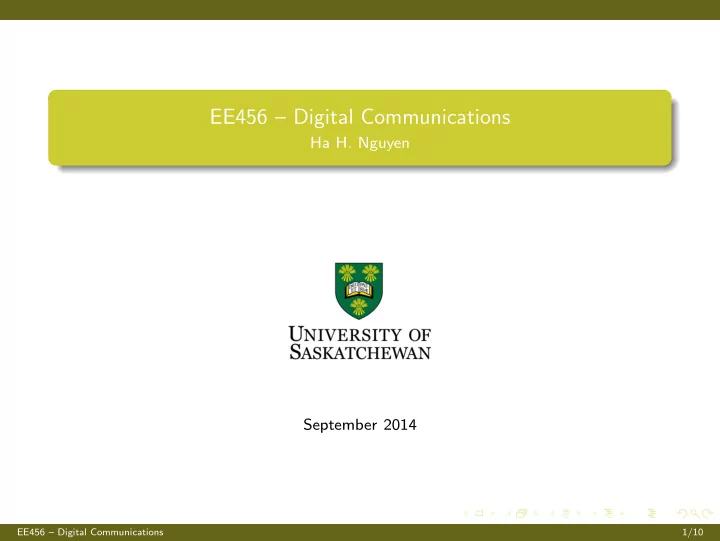

EE456 – Digital Communications Ha H. Nguyen September 2014 EE456 – Digital Communications 1/10
INTRODUCTION EE456 – Digital Communications 2/10
Communication Systems (Analog or Digital) Message Transmitted Received Detected signal signal signal signal Source Sink Transmitter Channel Receiver (User) (User) Distortion and noise Source: Originates a message (e.g., human voice, TV picture, email message) and converts it to an electrical waveform , referred to as a message signal. Transmitter (Modulator): Modifies the message signal for efficient transmission. Channel: A physical medium of choice that can convey the electrical signals at the transmitter output over a distance. Receiver (Demodulator): Processes the signal received from the channel by reversing the signal modifications made at the transmitter and removing the distortion made by the channel. Sink: Converts the electrical signal at the output of the receiver to its original form – the message. EE456 – Digital Communications 3/10
Analog, Digital, Continuous-Time, Discrete-Time? x ( t ) x ( t ) t t 0 (a) Analog continuous-time signal (b) Digital continuous-time signal T s t t 0 T s 0 (c) Analog discrete-time signal (d) Digital discrete-time signal In signal classification , the adjectives “analog” and “digital” refer to the amplitude property of the signals, while “continuous-time” and “discrete-time” refer to the time property. “continuous-time” and “discrete-time” are also commonly used to refer to the type of signal processing in hardware. EE456 – Digital Communications 4/10
What is Digital Communication? The message has to be in a digital format, i.e., it can be represented as a string of bits 0 and 1. A message can be analog (such as human voice) or digital (such as a computer-generated text document). An analog message can always be represented in a digital format through the processes of sampling and quantization . Digital Modulation: Over a finite duration, the transmitted signal belongs to a finite set of continuous-time waveforms . Note that each waveform in the set itself can be an analog continuous-time signal! Analog message 1 0 −1 0 0.5 1 1.5 2 2.5 3 3.5 4 4.5 5 t 1 AM signal 0 −1 0 0.5 1 1.5 2 2.5 3 3.5 4 4.5 5 t Digital message 1 0 −1 0 0.5 1 1.5 2 2.5 3 3.5 4 4.5 5 t BASK signal 1 0 −1 0 0.5 1 1.5 2 2.5 3 3.5 4 4.5 5 t EE456 – Digital Communications 5/10
Why Digital Communications? Transmitted AM 1 0 −1 0 0.5 1 1.5 2 2.5 3 3.5 4 4.5 5 t Received AM 2 0 −2 0 0.5 1 1.5 2 2.5 3 3.5 4 4.5 5 Transmitted BASK t 1 0 −1 0 0.5 1 1.5 2 2.5 3 3.5 4 4.5 5 t Received BASK 2 0 −2 0 0.5 1 1.5 2 2.5 3 3.5 4 4.5 5 t Since the transmitted signal in digital communications belong to a finite set of waveforms → The distorted signal can be recovered to its ideal shape, hence removing all the noise. EE456 – Digital Communications 6/10
Analog-to-Digital Conversion = Sampling + Quantization Sampling does not introduce information loss if it satisfies the Nyquist sampling theorem. Quantization always introduces information loss, but the loss can be made arbitrarily small by increasing the number of quantization levels (i.e., using more bits). EE456 – Digital Communications 7/10
Types of Modulation and Hardware Realization (Implementation) Continuous-time implementation is mostly adopted in this course (EE456) to explain the theory of digital communications (e.g., why do we use a certain modulation and demodulation methods?) Discrete-time implementation is most common in practice, but only briefly discussed in this course. Discrete-time implementation has to do with how efficiently one can build modulation/demodulation methods in hardware. This is the focus of EE465 in Term 2. EE456 – Digital Communications 8/10
Block Diagram of a Digital Communication System Synchronization Source Sink Transmitter Channel Receiver (User) (User) (a) Transmitter Receiver Source Channel De- Channel Source Modulator Encoder Encoder modulator Decoder Decoder (b) EE456 – Digital Communications 9/10
Digital vs. Analog Communications Advantages: Digital signals are much easier to be regenerated. Digital circuits are less subject to distortion and interference. Digital circuits are more reliable and can be produced at a lower cost than analog circuits. It is more flexible to implement digital hardware than analog hardware. Digital signals are beneficial from digital signal processing (DSP) techniques. Disadvantages: Heavy signal processing. Synchronization is crucial. Larger transmission bandwidth. Non-graceful degradation. EE456 – Digital Communications 10/10
Recommend
More recommend